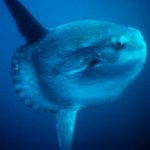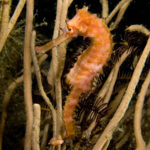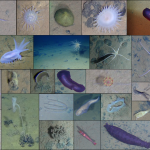Michael Phelps is faster than a flounder. He swims about 6 mph. But what if he was fighting currents, swimming upstream, and jumping dams? Salmon, dolphin, and blue shark are all faster. Salmon swim 8 mph. Maybe Mike could take them in a sprint. Swordfish and sailfish top the scales at 60 mph.
Jennifer Viegas’ “Born Animal” blog runs the stats at Discovery News.







“what if he was fighting currents, swimming upstream, and jumping dams”
Excellent point, Peter. Fish and other marine animals deal with a lot of obstacles that human swimmers don’t have to face. We’re not built for swimming, however, so it’s a miracle that any athlete can beat any fish. Phelps is more like a dolphin, though. His trainers even study dolphin swim techniques.
Thanks for checking out Born Animal!
Jen
There should be a swimming obstacle course in the olympics!
There is a sea-swimming competition at the Olympics, a guy from my town is selected to enter it.
And maybe one day there will be finswimming competitions. Monofin is the closest we can come to dolphins, ‘closest’ meaning lagging very far behind.
“We’re not built for swimming.”??? Actually, man has remarkable adaptions that appear to be useful for swimming and little else. Some researchers argue that these adaptations indicate humankind spent a long perid of our evolution on tropical sea shores.
1. We have webbing (however minimal) between our fingers, unlike any of the other primates, which makes us more efficient paddlers.
2. We are relatively hairless so that we don’t soak up a heavy burden of water (only an advantage in a warm climate). Conversely, less hair means we dry off quickly and are less likely to chill.
3. We store fat outside of our muscles to provide insulation and bouyancy.
4. Our nose is remarkably well designed to enable breathing while swimming — not flat like nearly all of our cousins.
5. Early on, infants instinctively know how to swim. After about six months that instinct disappears and they have to be taught.
No, unlike fish, we are not purpose-built for swimming. But some fish have adaptations that enable them to “fly” or “walk.” Humans don’t even require those quotation marks, we swim. In fact, with conditioning, we can swim with relative ease for distances of 3 to 20 miles. Whales and dolphins aside, how many other mammals are adapted to do that?
Besides everyone knows we are actually aquatic apes.
http://en.wikipedia.org/wiki/Aquatic_ape_hypothesis
>>”Whales and dolphins aside, how many other mammals are adapted to do that?”
Maybe one or two species of seal…
Huh? Apes and monkeys have just as much webbing as we do, so far as I can see from their hands. A certain amount of webbing is unavoidable, just from the way the skin folds.
Drying off causes a chill–we dry by evaporation. If we dried off more slowly, we’d stay warmer. Furthermore, because we’re hairless, we can’t trap a still layer of water or air next to our skin the way furry mammals can. So we’re doubly vulnerable to wind chill.
Small aquatic mammals which pop in and out of cold water are particularly vulnerable to heat loss. Think of beavers and otters. They have exceptionally thick fur.
All mammals store fat outside of their muscles. Intramuscular fat is unusually abundant in ruminants, particularly the livestock we’ve bred for more marbling; pretty much everyone else stores their fat around their viscera and under the skin, just like us. Other apes and monkeys put on fat in exactly the same spots we do when they’re overfed. (And remember, almost all of us modern first-worlders are packing far more fat than would a healthy prehistoric hominid.)
Furthermore, our fat layer actually does little to insulate us. It’s too thin–hairless marine mammals have much thicker layers–and we have lots of blood vessels running outside our fat, exactly where they shouldn’t be if we want to avoid heat loss.
That must be why so many swimmers wear noseclips!
When we swim, our faces are usually angled downwards. A projecting nose is harder to get clear of the water than a flat one. Furthermore, other catarrhines–apes and old world monkeys–have downward-facing nostrils just as we do. If anything, they have a slight edge in breathing while swimming.
Correction–young infants instinctively start to move, in a dog-paddlish manner, when placed in water. This doesn’t equate to successfully swimming in water, since they don’t raise their heads in a way that permits them to breathe. To paraphrase Buzz Lightyear, they’re drowning with style.
And, again, other mammals show a similar behavior–infant rats, kittens, monkeys, and so forth. They likewise lose that instinct as they age.
Marathon swimmers are a rather rarefied breed, though, combining exceptional talent and a lot of time devoted to conditioning. They’re hardly representative of the average human’s swimming ability. Most of us, even with a decent amount of swimming experience, would not consider a 10-mile swim “easy.”
Seals, polar bears, sea otters and beavers, of course. Sticking to generally terrestrial mammals, moose, elk and deer are all good swimmers. Deer have been clocked swimming at 13 miles an hour, and have been found five miles offshore; moose have made it to islands 15-24 miles from shore. Elephants can cover dozens of miles by water (and they are fairly likely to have gone through a semi-aquatic phase of evolution). Pigs can swim for miles; there’s a population of feral pigs in the Tokelau islands that spends all of high tide paddling, foraging for fish and shellfish. There are a couple of dogs who swim long distances at speeds comparable to human marathon swimmers. Heck, a Norway rat swam a quarter-mile across the ocean between NZ islands.
Most relevantly, crab-eating macaques and proboscis monkeys spend tons of time swimming and diving. Behaviorally they’re considerably more aquatic than we are, yet they’re not hairless, don’t have our fat, and (except for the proboscis males) have flat noses.
>>”Whales and dolphins aside, how many other mammals are adapted to do that?”
platypus? Hedgohogs? moles? desmans? rats? water voles? beavers? capybura? coypu? seals and sea lions? mink? otter? manatees? elephants? bears? raccoons? dogs? fishing cats? horses? hippopotamus? various monkeys?
According some of the adults at the MBA when I work there, penguins too. Some thought they were fish too. The kids always seemed to get it right though.
Apparently human sports swimmers maintain a fast swimming speed than right whales. Note however that right whales are often at the surface, and drag and turbulence are far higher there than below, so high speed is much more energy costly than swimming below the surface like other marine mammals. One can’t really say humans can swim faster than whales, except in that instance. All humans can swim faster than a mollusk, and can collect and eat them too along seashores.
No monkey or other anthropoid backfloats, humans do, this allows resting and swimming for longer periods. Humans infants can be taught to swim-roll-backfloat-roll-swim, unlike other primates.
All humans can swim faster than a mollusk
I don’t know what the speeds are, but I’m sure a jet-propelled giant squid would be able to catch a person.
All mammals can swim faster than a sessile organism. What’s your point?
As for the backfloating thing…first, the idea that backfloating readily allows for rest after distance swimming is contrary to my experience; second, [CITATION NEEDED]; and third, how about a response to some of the criticisms?
Seriously, your entire post belongs in a textbook entry on selective interpretation of data and/or confirmation bias.
Note: yes, people do catch mollusks along the seashore. A fair number of people are drowned doing this annually, which is kind of hard to reconcile with the idea that we evolved to be well-adapted to it. How many drowned walruses are you aware of?
DDeden, review this.
Actually, they don’t. Right whales typically cruise at 6 km/hr for hours, and can do 11 km/hr in short bursts.
The human swimming speed record is about 8 km/hr. Most Olympic gold medalists don’t manage much above 7 km/hr, even on a very short (25m) course in a nice calm pool–by the time you get to the 400m and longer events, speed records are below 6 km/hr. And, of course, the average fit and experienced human swimmer is not Olympics material–would you say humans are adapted to lift massive weights because Hossein Rezazadeh can heft 560 pounds?
As Kevin points out, cephalopods are mollusks. Squid can do 25 mph via jet propulsion, and I’d be surprised if any octopi (other than the gelatinous deep-sea ones) had trouble outdistancing a human swimmer. But, yes, humans can certainly outpace a clam.
Raccoons also collect mollusks along the shore; so do the pigs of Tokelau. You don’t need much in the way of aquatic adaptations to do that. (Although raccoons, unlike humans, have extremely sensitive but tough and cold-resistant fingers, making them much better at feeling around for underwater invertebrates.)
Survival floating–floating on one’s stomach–costs less energy than backfloating, and is safer in the ocean; you’re less likely to get water up the nose. It’s also generally the first float we teach to children.
And…infants? Children generally can’t learn to swim effectively until they’re 4 or so. Human infants can be taught to be comfortable in the water, which certainly helps them learn to swim when older, but they’re not any less likely to drown.
DDeden, review this.
DDeden has seen my site already, Azkyroth, and I don’t think it’s going to sway him. Of course it can’t be easy swaying someone who (honest) “creates” things like the Traix — “replaces 80% fossil fueled non-freight motor vehicle transit” — and the “Siber-Alaskan Solar Pipeline”? Interested parties see “David Deden Designs” for details.